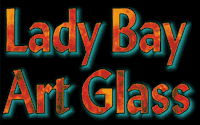 |
|
|||||||
All content is
© Lady Bay Art Glass. Reproduction in whole or part is not permitted.
Whilst we understand that it is possible to copy anything on this site we ask that you only do so for your own immediate viewing and that if you want to use parts of this site for other purposes you should ask our permission first.
Louis Comfort Tiffany
Louis Comfort Tiffany, artist, designer, entrepreneur, was responsible for changing the face of ecclesiastical glazing in North America, but his influence was global. He was part of the Tiffany family who owned the famous New York jewellers but he was primarily an artist with his own vision. He is principally known now for his Favrile glassware and his lamps, but these were an offshoot of the principal work of his company which was the manufacture of domestic and ecclesiastical windows. These differed considerably from European windows in that Tiffany used the glass as his pallette rather than as the canvas for paint effects. His use of enamels and stains was confined mainly to the details of faces, hands and feet. In order to get the kind of glass that he wanted he had to produce it himself, developing semi-transparent glass with a variety of textures and intermixing of colours.
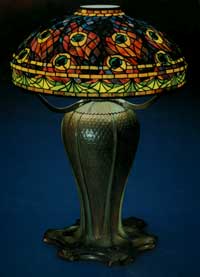 |
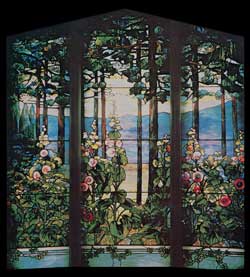 |
Tiffany peacock lamp . |
Typical Tiffany pictorial window . |
Construction
Tiffany developed a method of assembling small, intricate pieces of glass to construct a picture using the colours inherent in the glass. He used narrow strips of copper foil to create a U around the edge of each piece of glass so that a joint could be formed on top of the copper using lead solder. This allowed for much more detailed joints and also allowed glass to be 'plated', a process which involved the building up of layers of glass one on top of the other to achieve the desired colour variation and density. It also permitted the use of glass that would never fit in to lead came, glass with extremes of texture such as the drapery glass he developed which had very deep folds.
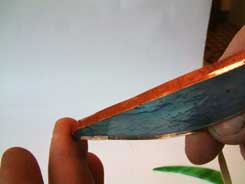 |
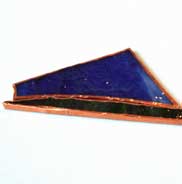 |
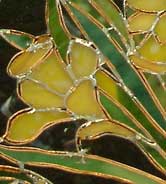 |
Wrapping the adhesive copper |
When smoothed down the foil acts as a |
Glass pieces tack soldered together. |
Nowadays within the stained glass world 'Tiffany' is used to describe the method of construction as much as it refers to the man. This type of construction is not suitable for external windows unless reinforcement is provided for the panel since these panels are not as rigid as a lead came panel.
Commissions
We don't often get asked to make 'Tiffany' panels since they are not always suitable for the location and they tend to be expensive because of the amount of work involved. However we have two examples to show here. The first is in a door to a 1920's house completed a number of years ago. It is a classic Tiffany theme of wisteria with lake and hills in the background. We used two layers of glass in a number of places to get the right effect, notably for the water. Lots of ring mottled and streaky glass gives the impression of a more complex panel. Ripple and herringbone ripple glass adds depth to some of the foliage.
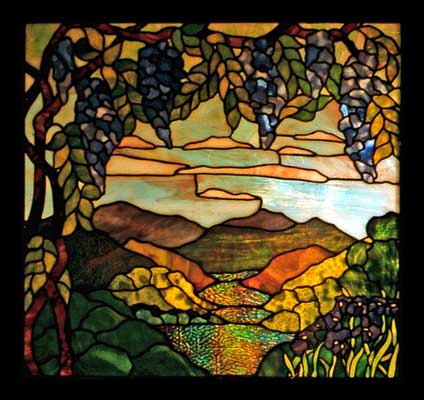 |
Our interpretation of a Tiffany wisteria Panel |
A more recent commission is a replica of well known Tiffany Daffodil panel. The original had quite a lot of blue and yellow streaky glass for the sky. This proved to be the most difficult problem to surmount as none of the importers of glass in the UK had anything resembling this colour combination so blue and white was substituted instead.
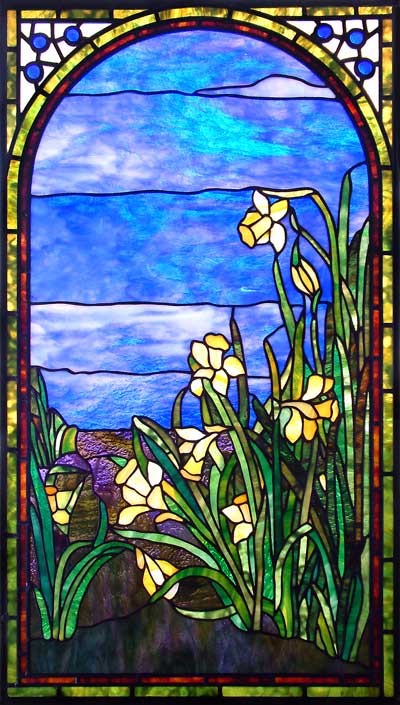 |
Our version of the Tiffany daffodil panel |
No plating could be used for this panel as its situation required it to be viewed and lit from both sides. The glass chosen for the leaves came from stocks that we have held for many years and includes some glass no longer available in the UK such as Chicago Art Glass and Oceana. A lot of the glass also has a very definite texture, some a granite texture and others a ripple texture and these add to the depth of character of the panel. The construction is a combination of copper foil and traditional lead came. The solder and lead have both been treated to create the same patina on both.
If you are considering commissioning such a panel the first steps should be to consider what glass types and colours are available. Tiffany had his own factory making glass and could have glass made to his specification for a particular project. Unfortunately the market for glass in the UK is small, so much of the quality glass produced in the USA does not get imported here. By all means contact us to arrange to view the glass available for this type of project, at which time we will also be able to advise which glass colours and types are currently being imported.
